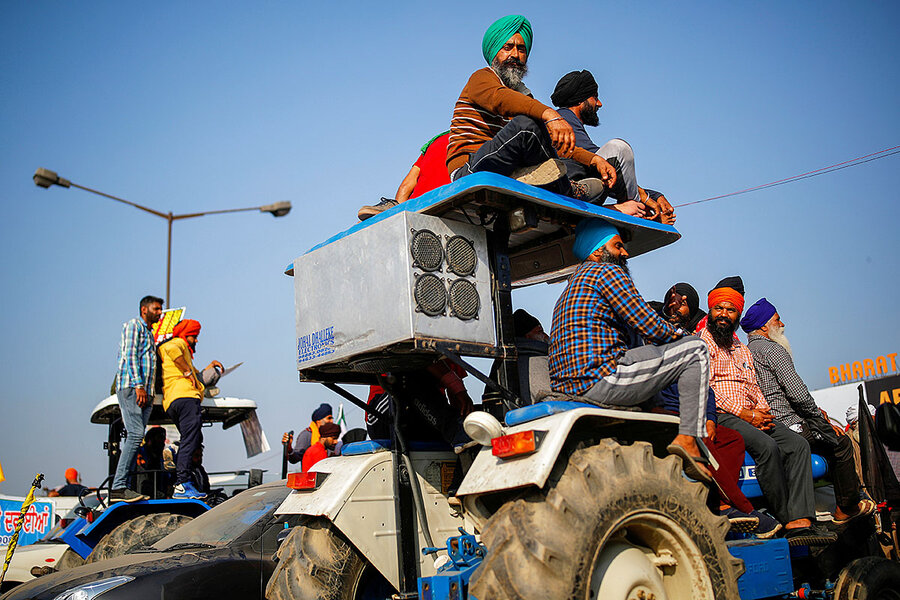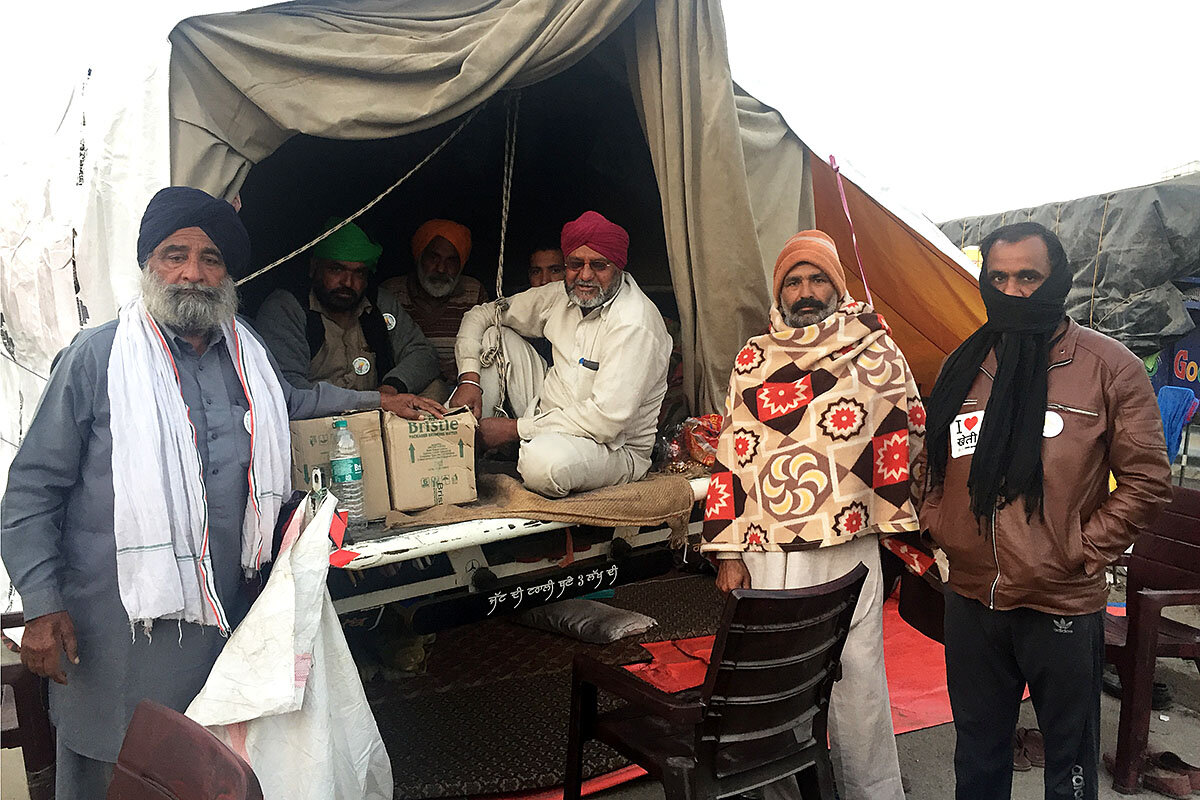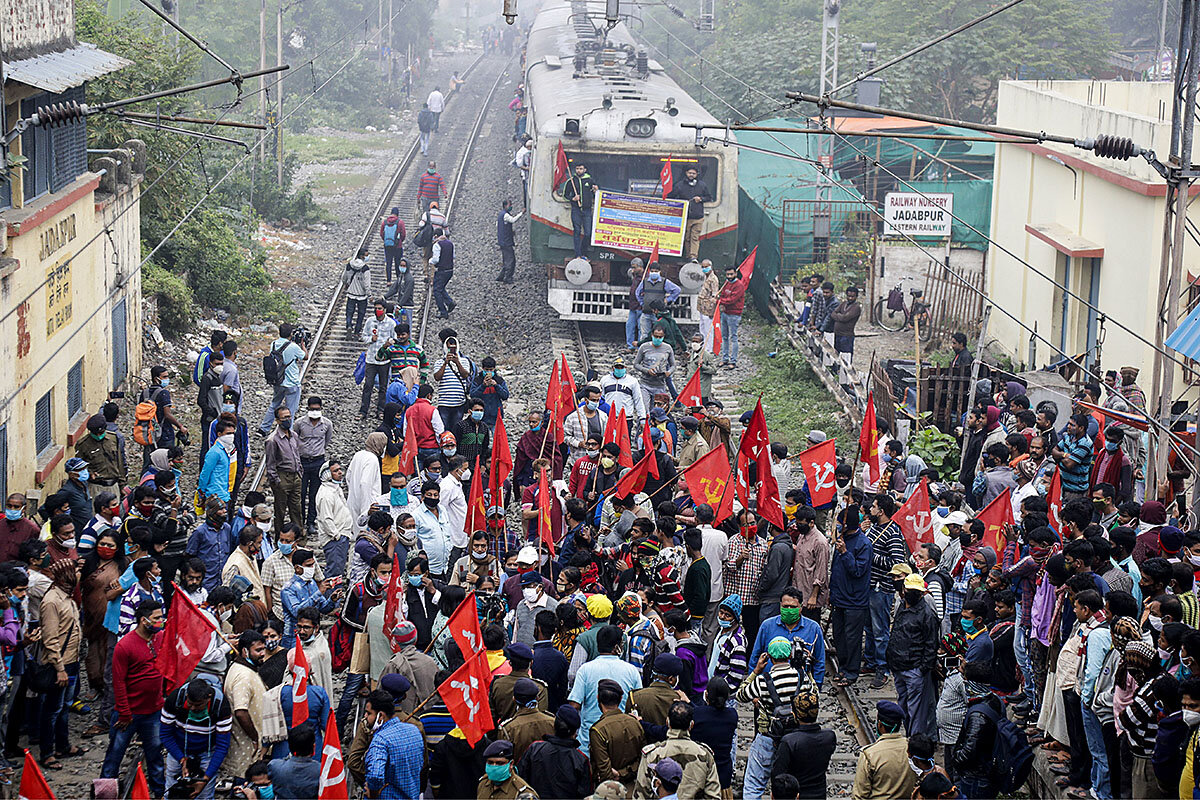Why India’s protesting farmers aren’t going home
Loading...
| New Delhi
At a certain point at the northern edge of India’s capital, New Delhi, the highway abruptly gives way to police barricades. Usually busy with vehicles making their way to the neighboring state of Haryana, traffic now comes to a dead stop. Stretching for miles after that are trucks and tractor-trailers that thousands of farmers used to get here, now parked to block the so-called Singhu border between states in protest.
Huddled with a few others in the rear of one of these tractor-trailers on a chilly December evening is Ram Singh, a wheat and rice farmer from Bhodi village in Haryana. He traveled about 140 miles to join this weekslong protest, demanding that the government rescind three hastily enacted agricultural laws. Like others gathered here, he believes that the laws will reduce his earnings while benefiting large corporations.
The legislation effectively deregulates the marketing of produce, limiting the role of government-run markets and price support systems. Prime Minister Narendra Modi has hailed this as a landmark reform that will remove middlemen and allow farmers to sell directly to large institutional buyers and retailers. Critics argue that farmers will not have the negotiating power to do so, and could be at the mercy of two billionaires who own large conglomerates. Additionally, one of the laws restrains citizens from taking disputes under it to regular courts.
Why We Wrote This
Agriculture employs hundreds of millions in India. But that’s not the only reason farmers’ protests have resonated so widely. They tap into concern over shrinking space for consultation, debate, and dissent.
“There will be hoarding. What is 10 rupees a kilo today they [corporates] will sell for 100 rupees a kilo tomorrow with their profits in mind. Along with farmers, this will affect laborers, shopkeepers, even city residents who’ll have to pay a hefty price,” Mr. Singh says. “This is everyone’s loss – marginal farmers, landowners, laborers. We are all in this together.”
Since Prime Minister Modi took office in 2014, his administration has veered to the right, prompting complaints about shrinking space for dissent and diversity – criticism that Hindu nationalists in his Bharatiya Janata Party often dismiss as “anti-national.” But agriculture employs half of India’s workforce, making the farmers’ protests one of the most serious challenges yet to Mr. Modi’s populist image.
Farmers at the Singhu border have been here for over 20 days, and there is no sign of a retreat. Support has been pouring in from different parts of the country. “More farmers are joining us next week,” Mr. Singh adds. “Most of our wives and children are back home for now, but they’ll join us, too, if needed.” At least 25 protesters have died, many of them due to the cold.
A large stage has been set up for speeches, and open-air kitchens serve meals throughout the day. There are trucks handing out oranges, and stalls distributing hot cups of tea and bowls of kheer, an Indian pudding. Temporary salons have sprung up, as have several shaded areas lined with cushions where farmers can rest. In one of them, young Sikh men carefully wrap turbans around the heads of fellow protesters. Medical students and doctors offer free checkups and medicines. A few waterproof tents offer some protection from the cold. For now, these roads and trailers are their home.
Rising public distrust
While the agricultural laws served as an immediate trigger, experts say it’s important to not look at them in a vacuum. The agricultural sector faces a deepening crisis, with a large percentage of farmers carrying mounting debts. Over 10,000 farmers died by suicide in 2019. As Indians reel amid the ongoing pandemic, its economic consequences have also fed frustration.
“There is a lot of simmering discontent among migrant and other workers, and this will grow because the economic conditions continue to deteriorate and people are losing livelihoods and lakhs [hundreds of thousands] of small enterprises are going under,” says Jayati Ghosh, a development economist. “Also, the idea that these laws were passed to benefit cronies has taken root.”
In the face of erratic weather patterns, water scarcity, rising debts, and insufficient government support, farmers from across the country have taken to the streets numerous times in the past few years. This time, however, their anger is directed at Modi’s government and its business allies. Across the country, farmers’ groups echo similar sentiments: They cannot trust the government.
Parliament passed the trio of laws in September over vehement protest by opposition parties. Outside, farmers in Punjab and Haryana states had already begun to demonstrate, arguing that the laws did not serve their interests and they had not been sufficiently consulted.
“This government has developed a reputation for making big decisions with little to no consultation with other stakeholders,” says Irfan Nooruddin, director of the South Asia Center at the Atlantic Council in Washington, D.C. From demonitization of Indian bank notes in 2016, to revoking Kashmir’s statehood last year, or the Citizenship Amendment Act last winter, major decisions have been “dropped on the Indian public in surprise.”
Each time, the government has justified these decisions as beneficial policies on major issues that have been lingering for a long time and needed tough, decisive actions.
“The consequence is that affected groups feel little recourse to influence the government other than by protests and demonstrations after the fact since the government shows little appetite for consensus-building,” Mr. Nooruddin says.
Long road ahead
Posters at the Singhu border declare, “We are farmers. We are not terrorists.” It’s a reference to how the government responded to those marching toward Delhi last month: barbed-wire fences, tear gas, and water cannons. Pro-government media have accused the farmers of being “brainwashed” by misinformation about the bill.
In such turbulent times, the farmers’ protest has become a symbol of a larger kind of dissent, reflecting concerns about democratic ideals and human rights. At Tikri border, another protest site, farmers raised pictures of human rights activists and intellectuals detained under an anti-terror law and called for their release.
The images of the protests create a public relations dilemma for the government, Mr. Nooruddin says. “Farmers have a powerful symbolic place in Indian society and cannot be as easily dismissed as ‘elites’ who are out of touch with the general national mood.”
During India’s last mass protests, against the citizenship law for refugees that excluded Muslims, the government portrayed protesters as unpatriotic radicals. But this time, officials are willing to talk. Six rounds of discussions with farm union leaders, however, have failed to bear any results. Farmers are adamant that the laws be revoked, not amended.
In Singhu border, Sher Singh, a farmer from Punjab, is helping to unload vegetables and takes a minute to step aside and talk. “Those in power, they dream of a Hindu nation,” he says, referring to the ruling party’s Hindu nationalist agenda. “What nation? When ordinary citizens like us are hurting so much, what is the point of all this nation-building?”







